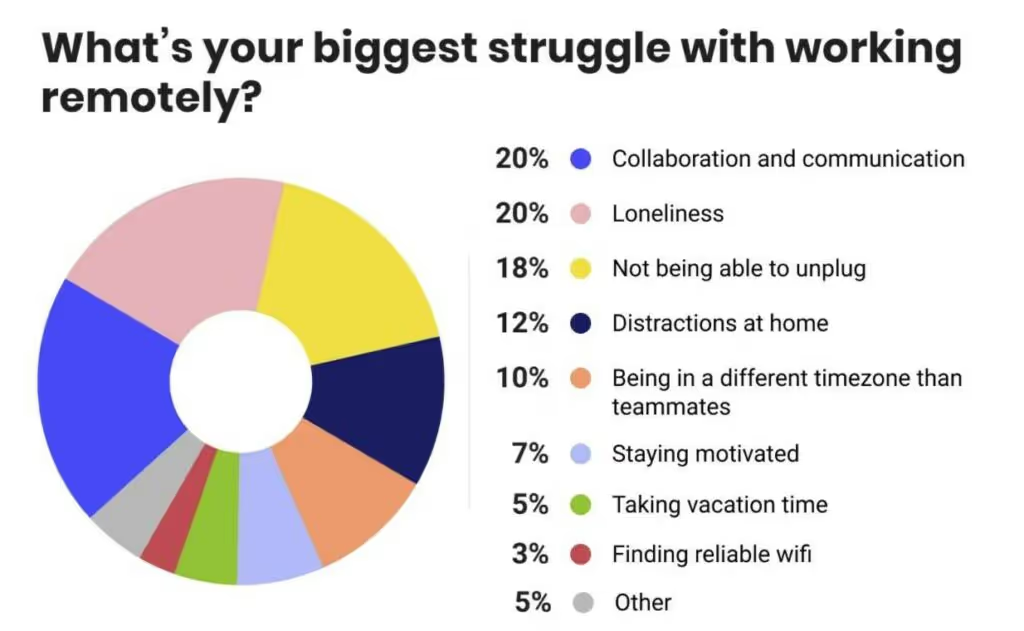56% of US companies have been increasing their level of remote work, according to a 2021 survey.
But as more and more workers operate from different locations, managers around the globe are facing the uncharted territory of managing remote teams. And that’s as if managing a team wasn’t hard enough already in person.
Regardless, the hardship of managing remote teams is a small price to pay for the benefits they offer. Plus, how you handle this new reality of work will shape your true potential as a leader.
So consider this post as your go-to guide for managing remote teams. We’ll begin with some common challenges that plague virtual managers, followed by our best strategies to lead your remote team with confidence.
Challenges of managing remote teams
Working from home seems normal these days, but many organizations didn’t have remote work on their radar until the global pandemic forced them to.
Before we get to the remote management strategies, let’s see some key challenges faced by leaders and their team members when adapting to this new way of working.
Shifting to a new structure
Human beings are creatures of habit. From that morning commute to the evening snack, our daily work routines have probably been pretty consistent.
When you and your team members start working remotely, everything can get upside down. You are forced to establish a new routine, along with juggling your personal and professional duties outside the office, factory, or wherever you used to work before.
Plus, it doesn’t help that you are now supposed to deal with a lot of new virtual tools, communication methods, and remote work policies. No wonder managing remote teams seems overwhelming.
Adopting tech-based communication
Facing an issue, or need a second opinion on something? Just go to your nearest team member and sort it all out in a second.
This is possible in an office, but may feel like a distant dream in today’s remote working environment, too good to be true!
In fact, 45% of employees worry over not seeing their team members in person because of remote work, and 34% have doubts about their ability to collaborate virtually. Ensuring you're providing a good digital employe experience is key.
As communication moves to technologies such as email and instant messaging, managers and their team members are finding it hard to get the answers they need in time.
Juggling productive and personal time
Personal time at home. Work on site. It has been a simple rule to follow. When you work from an office, there’s a clear line between your professional and personal life, at least more straightforward than the boundaries set by remote work.
With remote work, the lines are blurred. It’s easy for the personal responsibilities to distract you from your work, or for your work to eat up your family time. So both managers and their employees are faced with the issue of striking a balance between the two.

Building trust and rapport
When managing remote teams, you want to keep your team members assured that you are available to lead and support them. And that you’re in touch with their concerns, needs, and suggestions.
But when everyone is struggling to communicate efficiently, it gets increasingly difficult to do that. And with no visible body language and non-verbal cues, you may not get an accurate sense of their level of engagement, feelings, and emotional well-being.
We don’t mean to scare you with a laundry list of challenges of leading remote teams. But rather to drill down the fact that you’ll need to really pull up your sleeves for the job. To truly manage and engage remote teams, you should be ready to work harder than ever, which brings us to the next section.
Best practices for managing remote teams
Ready to learn the tips and tricks to manage remote teams the right way? Here’s how to get the best results from your remote employees.
1. Establish clear expectations
34% of remote workers worldwide say that transparency from leadership triggers a deep sense of connectedness at work. And a big part of transparency is setting clear rules and regulations for your team members.
When managing remote teams, it’s important to set boundaries and expectations that your team members are supposed to work with. For example, random video meetings may get awkward for some employees if they weren’t expecting them.
So you need to let your team members know exactly how you plan to manage them from a distance. This includes communicating the following:
- Values and behaviors that shape the company culture
- Remote work procedures
- Guidelines specific to their project
- Communication style guides
- Expectations regarding workload and availability
The best way to start implementing work expectations when managing virtual teams is to have a kick-off meeting to introduce all the policies and procedures. Then keep reinforcing them in regular weekly and monthly meetings.
2. Implement the right communication channels
Email has its place. But there are many different types of communication, not all of which are best-suited for emails. These include:
- Status updates
- Frequently used resources for team members
- Project schedule and deadlines
- Troubleshooting guide for common problems
Because of this, picking the right communication channels is crucial for managing remote teams.
For example, depending on the nature of communication, you may also want to use channels like instant messaging, virtual meetings, or cloud sharing from time to time. And if you want to limit the use of random video calls, you can establish email and online chat as the main communication channels for your team.

Avoid having too many different tools and channels as they can overwhelm your team and allow important messages to slip through the cracks. It’s better to use a single communication platform or employee engagement tool that consists of multiple communication streams.
Blink, for example, is a mobile app that allows team members to communicate via a social-media-style feed, instant messaging, and cloud-based document sharing — all from one place.
3. Set regular check-in times
When your team is working from an office, it’s easy to check in regularly with the whole group as well as individual team members. But don’t think you can’t do the same with remote teams.
In fact, if your team has just started working remotely, you might need to schedule extra check-ins until the team members have adapted successfully to the new routine. Then scale back based on what works for your team and the given workload.
For example, start with a daily meeting of 15-20 minutes. Go around in a circle and give each worker a chance to talk about their plan for the day, any issues they have, and what they need from other team members.
4. Invest in mental health and well-being
According to World Health Organization (WHO), anxiety and depression lead to productivity losses that cost the world $1 trillion annually.

Not just that. For every $1 that goes into workers’ mental health, there’s a return of $4 in terms of employee health and productivity.
When your team members are working remotely, their mental health should be an even higher priority for you than what it was in the office. Because with remote team management, you don’t have as many opportunities to identify what emotional challenges your workers are struggling with.
For example, some employees may find it easier to adapt to remote working and maintain sound health than others. And for the ones that don’t, you’ll need to identify and support them as per their needs. Some ways to do that include:
- Offering employee benefits related to mental health
- Encouraging open communication among team members
- Appointing a psychotherapist the employees can talk to
- Sharing guidelines and resources for self-care
- Encouraging workers to take frequent breaks
5. Celebrate both small and big wins
Achieving milestones together is what makes your team, a team. So when managing virtual teams, don’t let the physical distance come in the way of celebrating and rewarding accomplishments.
Celebrating successes will encourage your remote employees and motivate them to keep doing their best work. For example, you can host virtual parties, get a gift delivered to a team member’s doorstep, or give a bonus day off.
Also, don’t postpone a celebration in your wait for achieving something big. Even short-term successes count, especially when managing remote teams. Otherwise, your team members can easily feel discouraged.
6. Document everything
Managing remote teams can get real complicated, real fast. As you take your project activities from the physical world to a virtual environment, many key steps and tasks can slip through the cracks.
So for effective remote team management, it’s not enough to have the workflows, roles, and processes just in your head. The best way to retain and enhance team productivity is to document as much as possible and make the documentation easily accessible for all remote employees.
Create detailed documents that provide step-by-step breakdowns of all the things the team needs to get done, when to do them, and who is responsible for the work items. For example:
- Checklists and templates for routine tasks
- Playbooks that go deep into project protocols and procedures
- Flow charts showing what actions to take in dynamic circumstances
- Forms to record key information and instructions to fill them properly
To make sure your team can refer to these documents as needed, put them on a shared storage platform and set permissions for team members to access at any time. This will reduce bottlenecks and get the team members to complete their tasks efficiently.
7. Provide socializing opportunities
According to a Buffer survey, 20% of remote workers go through a heightened sense of loneliness, and another 20% find it difficult to collaborate and communicate.

So it’s vital to encourage social interactions among remote teams. You need to proactively create time and opportunities for employees to connect and socialize with one another.
Some of the best ways to do that include virtual hangouts, joint brainstorming sessions, morning coffee standups, online lunch and learns, and team-building games.
Conclusion: managing remote teams like a pro
As you can see, managing remote teams is not a piece of cake. It requires you to keep a close eye on not just the progress of tasks and project goals, but also team members’ emotional well-being and their relationships with one another.
No doubt, you’ll need to step up as a leader in some big ways. Some of the remote team management strategies we have covered may already be familiar to you, while others will need you to go out of your comfort zone.
Regardless, if you’re serious enough to be reading this article, we’re confident that you can handle managing remote teams with flying colors. So start following these best practices today, and see the difference they make in your remote team’s performance.
Plus, as we said earlier, consider using an all-in-one communication app that can make collaboration easy and bring team members together despite the physical distance that comes with remote work. Book a free blink demo.
Managing Remote Teams FAQs
How do you effectively manage a remote team?
Set clear expectations and goals, document everything and make sure you have clearly defined processes. Ensure you have the right communication tools, have regular check-ins and keep tabs on remote employees' wellbeing. Keep on top of employee recognition and if possible provide opportunities to socialise with the team.
How do you manage multiple teams remotely?
The same goes for managing multiple remote teams, communication and the tools you use will become even more important so make sure you choose these wisely. Ensuring you focus on structure, communication and recognition.
What is the key to success working remotely?
The key aspects of making working remotely a success can be boiled down to structure, communication and recognition.

